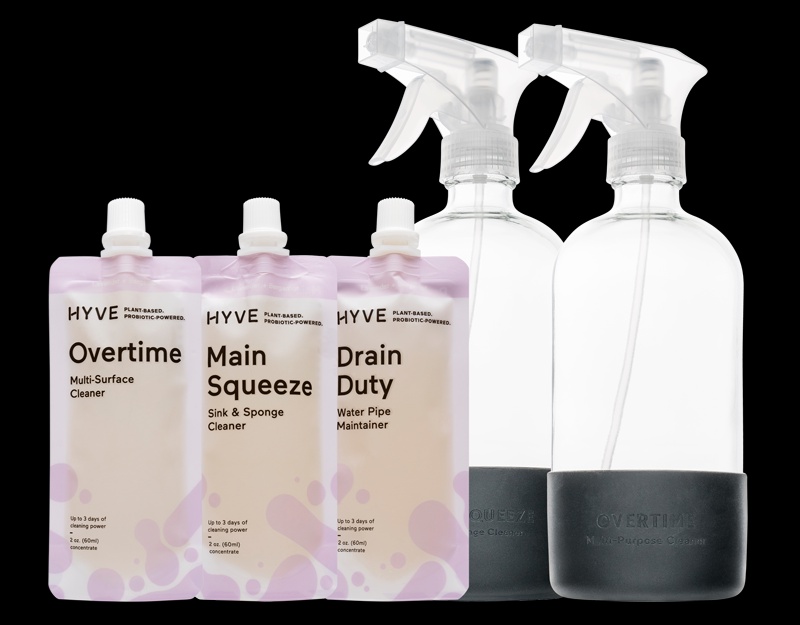In the wake of the COVID-19 pandemic, the significance of cleanliness within our homes has surged to unprecedented levels. The quest for a pristine living environment has taken center stage from routine tidying to rigorous disinfection.
Yet, amidst this fervor for hygiene, a hidden danger lurks within our cleaning routines, often overlooked: phthalates. These inconspicuous additives find their way into the products to safeguard our abodes.
While we diligently sanitize, these phthalates, employed to enhance fragrances and flexibility in cleaning agents, pose a subtle threat to our health and the planet. In this exploration, we journey into the ubiquitous realm of household cleaning, unearthing the dangerous nature of phthalates.
Moreover, we unveil an ally in pursuing a non-toxic household cleaning products haven: Hyve's revolutionary cleaning products. Join us as we navigate the realms of cleanliness, health, and sustainability, illuminating the path to a safer and cleaner future.
Let's Closely Understand What Phthalates Are?
Phthalates are a group of chemicals primarily used to improve plastic products' flexibility, durability, and longevity. In cleaning products, their main purpose is to enhance performance and sensory qualities. These chemicals are often utilized as plasticizers, making plastics more pliable and resistant to wear and tear.
What is their primary purpose in cleaning products?
Phthalates are chemical compounds present in cleaning products to enhance their fragrance, flexibility, and longevity. Their role in cleaning products goes beyond their plasticizing properties; they also help to disperse and stabilize fragrances, ensuring a longer-lasting and consistent scent in various cleaning formulations. Additionally, phthalates assist in maintaining the flexibility of cleaning tools and containers, preventing them from becoming brittle over time.
A. The various types of products where phthalates are commonly found.
Phthalates are commonly present in many cleaning products, including household cleaners, air fresheners, laundry detergents, and even personal care items such as shampoos and soaps. They can also be in vinyl or plastic materials used in mop heads, spray bottles, and scrubbing pads.
B. Why are phthalates used in cleaning products?
Phthalates present in cleaning products primarily to enhance fragrance, increase flexibility, and prolong product shelf life. They help cleaning solutions maintain a consistent and pleasant scent over time. Adding phthalates ensures that plastic components in cleaning tools remain supple, reducing the risk of breakage. Moreover, these chemicals assist in preventing the degradation of the product's overall quality, contributing to its longevity and effectiveness. Despite their advantages, concerns about potential health and environmental impacts have prompted a growing interest in developing phthalate-free alternatives in the cleaning product industry.
The Health Risks & Environmental Impacts of Phthalates
Phthalates pose both health risks and environmental impacts, raising concerns across various sectors:
1. Health Concerns:
Studies have linked phthalate exposure to adverse health effects, including disruptions in hormone regulation and potential reproductive issues. Certain phthalates cause endocrine disruptors, which can interfere with normal hormone function, potentially affecting growth, development, and fertility.
2. Developmental Effects:
Phthalates cause developmental abnormalities in children, including poor cognitive development and behavioral changes. They can also impact the respiratory and immune systems.
3. Environmental Persistence:
Phthalates are not easily biodegradable, leading to their accumulation in the environment. They can leach from products into soil and water, entering the food chain and affecting aquatic life.
4. Water and Soil Contamination:
Phthalates can contaminate water sources through runoff from products like cleaning agents, posing a risk to aquatic ecosystems and potentially reaching drinking water supplies.
5. Airborne Exposure:
Indoor air pollution can occur when phthalates evaporate from products. Inhalation of these particles can lead to respiratory irritation and other health concerns.
Enter Hyve's Cleaning Products- The Safer Cleaning Alternative-
Experience a new era of cleaning with Hyve's exceptional range of products, setting the standard for safer alternatives in the cleaning industry. With a strong commitment to health and sustainability, Hyve is a beacon of innovation in cleaning solutions where you can shop all-in-one cleaning products free from phthalates.
- Uncompromised Safety and Sustainabilityshop all in one cleaning products
Hyve prioritizes your well-being and the planet by formulating cleaning products with non-toxic and sustainable ingredients. Bid farewell to harsh chemicals that endanger your health and the environment. Embrace a cleaner future with Hyve's Drain Duty, Overtime, and Main Squeeze that align with your values.
- Key Features: Efficacy, Safety, and Eco-Friendliness
Hyve's products don't just clean; they excel. Count on the meticulously crafted formulas to effectively tackle dirt and grime while ensuring the utmost safety for you and your loved ones. Embracing eco-friendliness without compromising performance, our products leave a minimal environmental footprint.
Conclusion
Choosing safer alternatives is paramount in a world where phthalates in cleaning products pose risks to health and the environment. Hyve's products offer a beacon of hope, non-toxic cleaning products. By embracing this transition, we safeguard our well-being and the planet.
Now equipped with knowledge, let's stand together for a healthier world. Share this awareness, adopt conscious choices, and inspire change. We pave the way toward a cleaner, safer future with each decision.
Faq's
Q1: What are phthalates, and why are they concerning?
Phthalates are chemicals that enhance flexibility and fragrance in various products. They're concerned about their potential to disrupt hormones, impacting health and the environment.
Q2: Where can I find phthalates?
Phthalates lurk in many everyday items: plastic products, fragranced items like air fresheners, cleaning agents, personal care products, and food packaging.
Q3: How can phthalate exposure affect me?
Phthalates can lead to hormonal imbalances, affecting reproduction and development and potentially causing respiratory and immune issues.
Q4: How do I identify products with phthalates?
Check product labels for terms like "fragrance" or "phthalate," and opt for products that list their ingredients transparently.
Q5: Why should I choose phthalate-free products like Hyve?
Like Hyve's offerings, phthalate-free products prioritize your health and the environment. They offer effective cleaning without harmful side effects.


No comments yet